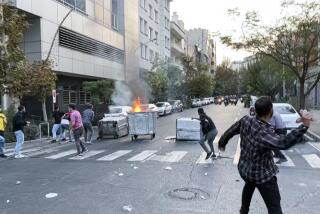A Deal With Dalai Lama Is Viewed as China’s Best Hope of Stabilizing Restive Tibet : Analysis
- Share via
BEIJING — For China, last week’s pro-independence rioting and imposition of martial law in the Tibetan capital of Lhasa underscored the possibility that a deal with the exiled Dalai Lama may be the only solution to Beijing’s intractable Tibet problem.
For nearly 40 years, Tibetan resentment has smoldered since the Chinese assumed firm control of the region. There was harsh repression during the Cultural Revolution of 1966-76, but China’s reformist leadership has tried in the last decade to assuage the Tibetans by allowing limited religious activity and promoting economic development.
That policy is far from dead. But whatever luster it had was blackened last week in the bonfires of Lhasa, as rampaging youths ransacked Chinese-owned stores and burned their contents in the street.
Police shot and killed at least 10 protesters last Sunday on the first day of the disturbances. Martial law was imposed at midnight Tuesday, and the death toll now stands at 16 by official count and 50 or more by unofficial Tibetan estimates.
Tibetan nationalists can be expected to redouble their efforts to break free of Beijing’s control, even as China intensifies its attempts to stabilize the region. Emotions on both sides were inflamed by last week’s events, and continued conflict seems inevitable.
The Dalai Lama, spiritual leader of the Tibetan people and former ruler of Tibet, remains the key to any solution that might satisfy both sides. It was his followers, Buddhist monks and nuns, who staged the pro-independence demonstration last Sunday that escalated into clashes with police.
In a proposal put forth last June in Strasbourg, France, the Dalai Lama, 53, expressed willingness to return to Tibet in his religious capacity if the region were guaranteed autonomy and democracy.
In explaining his willingness to compromise on the issue of full independence, the Dalai Lama has said he believes action must be taken relatively soon--within 10 or 20 years--to prevent the extinction of Tibetan religion, culture and language.
As he knows well, the balance of strength between China and Tibet is heavily in Beijing’s favor. China has far more firepower than it needs to crush any rebellion in the region, and no foreign power has indicated any interest in arming a Tibetan uprising.
Tibet, which is slightly smaller than Alaska, has a population of 2 million, and there are about 4 million ethnic Tibetans elsewhere in China.
Active resistance known to the outside world involves fewer than 1,000 Lhasa-area Buddhist monks and nuns, as well as the residents of the Tibetan quarter of Lhasa, an area of roughly one square mile.
Despite their efforts, it is highly unlikely that any Chinese government would allow Tibet to become independent, given its perceived strategic value and the belief of virtually all ethnic Chinese that the region is legitimately a part of China.
Advocacy of independence is illegal, and protesters or rioters are treated as traitors and criminals. Western human rights organizations repeatedly have reported allegations of torture in Tibetan prisons.
Still, if enough concessions could be granted to the Dalai Lama to persuade him to assume a pacifying, intermediary role, Tibet could be stabilized as a culturally distinct region of China. The much less influential Panchen Lama, Tibetan Buddhism’s second-ranking leader, had tried to play that role until his death in January.
Over the last six months, representatives of China and the Dalai Lama have engaged in delicate contacts aimed at opening negotiations. But now there is little room for compromise. Many of the Dalai Lama’s fellow Tibetan refugees in India feel that his proposal already has given away too much. Beijing, for its part, dismisses his ideas as a disguised attempt to win independence.
But even as the two sides exchanged angry words last week, neither ruled out the possibility of talks. Authorities in Lhasa have said martial law probably will be lifted by early April, with tourism likely to resume a few weeks later. The desire of officials in Beijing to keep the door open to the Dalai Lama, to minimize anti-Chinese resentment and to earn foreign exchange through tourism provides some constraints on their actions.
Tibet was part of the Chinese empire during the Qing Dynasty, but held de facto independence for 40 years after 1911. Through a combination of military pressure and political negotiations, the Chinese Communists took control in 1951 but did not immediately impose radical change.
In the last three decades, however, the region has been transformed in many ways. Even so, there is a sense of deja vu in the current standoff, which marks the 30th anniversary of a much greater uprising on March 10, 1959, that resulted in the Dalai Lama’s flight to India.
The Chinese crushed the revolt, then launched the so-called democratic reforms, stripping the great monasteries, landlords and old elite of their land and power. Some religious centers were razed, and in the early years of the Cultural Revolution, all but a few monasteries were destroyed.
These changes were supposed to raise the status of poor peasants, and to some extent they did. But there was great loss of life, and Tibetan culture suffered a devastating blow.
After religious life resumed in the early 1980s and Tibet was opened to tourists, it appeared that the bitter wounds of the past might slowly heal. But since Oct. 1, 1987, four major protests have broken out in Lhasa, each suppressed by police gunfire. Total deaths in the first three incidents numbered between 15 and 40.
Now, after last week’s even more serious rioting, Chinese troops are marking the 30th anniversary of the original revolt by again patrolling the streets of Lhasa, using martial law to suppress a population that has lost none of its adoration for the Dalai Lama.
In the absence of an agreement with the Dalai Lama, China has few options but to continue with the basic outlines of its present policies: repression of independence activists, matched with attempts to appease Tibetan sentiments by promoting the economy and Buddhism.
Repression can and probably will be stepped up, with reports by Tibetans in Lhasa last week that as many as 1,000 people already had been detained. Nationalistic monks may be harshly treated, but it seems unlikely that Beijing will again close the monasteries and wage all-out war on religious life.
In Beijing, some Western diplomats and other analysts believe that the trouble in Tibet strengthens hard-line Communist Party members critical of General Secretary Zhao Ziyang and his political allies, who have promoted the relaxation of ideological and social controls in China.
But even Zhao, widely viewed as China’s leading proponent of market-oriented economic reforms, takes a hard line toward independence activities in Tibet. On this point, the ruling Politburo, the military and ethnic Chinese throughout China are united.
Thus, some analysts argue, it actually strengthens the hand of reformers in Beijing to be able to show toughness by cracking down on unruly Tibetans--and such measures also may serve to warn any unhappy Chinese who might think of getting out of hand.
More to Read
Sign up for Essential California
The most important California stories and recommendations in your inbox every morning.
You may occasionally receive promotional content from the Los Angeles Times.













